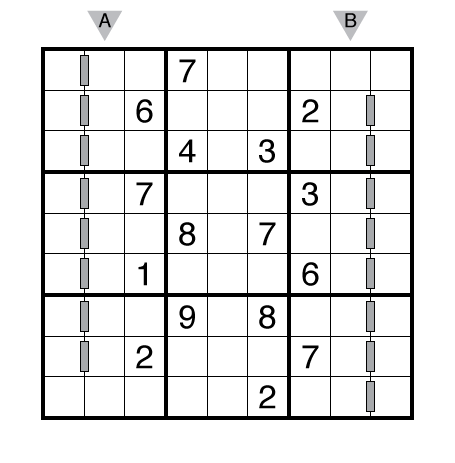Dr. Sudoku Prescribes #88 – Consecutive Sudoku

or solve online (using our beta test of Penpa-Edit tools)
Theme: Walls
Rules: Standard Consecutive Sudoku rules.
Answer String: Enter the 2nd column from top to bottom, followed by a comma, followed by the 8th column from top to bottom.
Time Standards (highlight to view): Grandmaster = 3:15, Master = 5:00, Expert = 10:00
Solution: PDF

I must have used a rather unconventional break in, seeing how I worked out A and B with nearly all of the center 3 columns empty. What I ended up doing was to deduce which numbers must form a consecutive pair, and write down those pairs on the side. The set of pairs chain pretty well once you get enough of them out, and the whole thing worked before I did much of anything in the center.
This is a puzzle where the three vertical chutes can solve somewhat independently. I didn’t feel like choosing an extra entry bit, and I liked the chained pairs on the outside more than the “standard” middle when I had to make a choice.
Noticeable structure of the solved grid mod 3. Was that forced by the theme, chosen intentionally, or neither?
I’d definitely say this is a consequence of the design of bars. I tested the pattern more broadly and find only 168 solutions to this grid, all with this structure.
There are a lot of hard to see constraints in making consecutive puzzles which often leads to oddities like this (well, frequently this specific oddity) — and also why a lot of consecutive puzzles have imperfect themes in the bars as you can’t avoid pairs very frequently. I first learned this the hard way when Wei-Hwa gave me a 7 given non-consecutive puzzle while working on Mutant Sudoku that I could do absolutely nothing with.
I was going to say something along the same lines. Getting a valid solution out of an a priori nice looking consecutive puzzle is a massively constrained challenge. I suppose I’m not surprised that getting something to fit required the help of a computer search, and this is one of the reasons i’m teaching myself to program. Highly customised generators do have a place in sudoku!
My construction style varies a lot based on type but I probably use code the most nowadays with this style of sudoku. Nothing wrong with tools as long as a human is still guiding the end-result.
Specifically, with consecutives I check if a pattern has any solutions (and a sense of how many) before I try to build anything. Here there really were not a lot of choices, so after specifying a couple digits (even fewer than these 16) you can have a finished puzzle. I remember wanting to make a smiley face for Mutant Sudoku and checking about 16 different patterns for a clean puzzle. Only one of the 16 smiles, a particularly evil looking one, had any solutions at all.
1’50, starting with the central columns – but looking at the puzzle again I see that the horizontal option was a good one too (although maybe not as fast). A bit surprised by the target times here since I found the puzzle really easy. Do you have an idea of which path had the favor of your test-solvers?
I actually removed some givens after my first test and likely overcompensated on the overall time. I could probably stand to have a few more sudoku specialists as testers as I almost always base the grandmaster time on what I think I would have taken myself, which I don’t need to do with any of the puzzle times.
4’14” – Beautiful sudoku motris!!!!Loved the solve path.Would want this sudoku season to continue more.Thnks for the nice sudoku
I wanted to ask about an oddity vertical in each block in the solved grid but I guess that is the same as mentioned above as ‘mod 3’… Nice & easy !